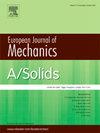双环戊二烯基聚合物(DCPD)和GFRP在汽车行业的结构行为
IF 4.4
2区 工程技术
Q1 MECHANICS
引用次数: 0
摘要
在汽车工业中,对组成车辆的部件有透彻的了解是至关重要的。这项工作是一个研究项目的一部分,该项目使用ECE R29法规适应性评估单层客车的结构完整性。本研究旨在评估用更环保的双环戊二烯基聚合物(DCPD)制成的面板取代目前由玻璃纤维增强聚合物(GFRP)制成的外墙面板。为了实现这一点,必须评估不同材料的有效性和抗冲击性。该材料的冲击性能可以通过典型的测试装置进行预测,该装置采用气动气枪装置模拟小规模碰撞,能够发射通常应用于弹道学和航空学的硬质弹丸,突出了该研究的多学科性质。开发了一种定制设计的发射机制,通过3D DIC测量材料的能量吸收和穿透能力来评估材料。冲击后分析使用脉冲热成像来表征穿孔和非穿孔冲击造成的损伤。设计用于耐撞性测试的设备被证明是成功的,并显示出超出典型的弹道和航空应用的应用潜力。使用锁紧热成像技术可以进行详细的裂缝分析。在结构性能方面,根据欧洲经委会R29法规,当受到低速冲击和类似能量时,DCPD被发现是纳入教练员设计的更好候选材料。然而,对于高能撞击(713 kJ以上),DCPD在受到球形弹丸撞击时,会发生径向断裂,使其吸收能量的效率低下。在这种情况下,GFRP被认为更有能力保持整体部件的完整性。本文章由计算机程序翻译,如有差异,请以英文原文为准。
Structural behaviour of dicyclopentadiene-based polymers (DCPD) and GFRP in the automotive sector
A thorough understanding of the components that make up a vehicle is crucial in the automotive industry. This work is part of a research project in which a single-deck coach was evaluated for structural integrity using an ECE R29 regulation adaptation. This research aims to evaluate the replacement of the current exterior panels made of glass-fibre-reinforced polymer (GFRP), with more environmentally friendly panels manufactured of dicyclopentadiene-based polymers (DCPD). To achieve this, the effectiveness and impact resistance of the different materials must be assessed.
The impact performance of the material may be predicted using a typical testing device that simulates small-scale collisions employing a pneumatic gas-gun setup capable of firing hard projectiles commonly applied in ballistics and aeronautics, highlighting the multidisciplinary nature of the study. A custom-designed firing mechanism was developed to evaluate materials by measuring their energy absorption and penetration capacity using 3D DIC. Post-impact analysis uses pulse thermography to characterise the damage from both piercing and non-piercing impacts.
The equipment designed for crashworthiness testing proved successful and shows potential for applications beyond the typical ballistic and aeronautical applications. The use of lock-in thermography enabled detailed fracture analysis. In terms of structural behaviour, DCPD was found to be a better candidate material for incorporating into the design of coaches when subjected to low velocities impact and similar energy under the ECE R29 regulation. However, for high-energy impacts (above 713 kJ), DCPD, when impacted by a spheric projectile, tends to fracture radially, making it inefficient for energy absorption. In such cases, GFRP is considered more capable of maintaining the integrity of the overall components.
求助全文
通过发布文献求助,成功后即可免费获取论文全文。
去求助
来源期刊
CiteScore
7.00
自引率
7.30%
发文量
275
审稿时长
48 days
期刊介绍:
The European Journal of Mechanics endash; A/Solids continues to publish articles in English in all areas of Solid Mechanics from the physical and mathematical basis to materials engineering, technological applications and methods of modern computational mechanics, both pure and applied research.

 求助内容:
求助内容: 应助结果提醒方式:
应助结果提醒方式:


